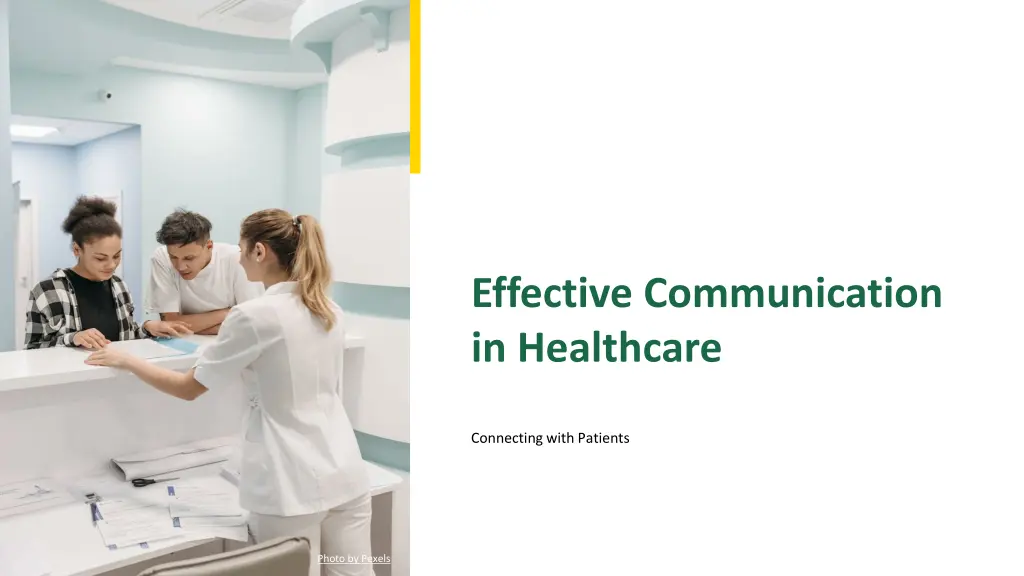
Effective Communication in Healthcare: Connecting with Patients
Learn the core components of effective communication in healthcare, including building rapport, active listening techniques, the power of body language, empathy in healthcare, and more. Enhance patient engagement, trust, and satisfaction by mastering these essential communication strategies. Photo by Pexels.
Uploaded on | 4 Views
Download Presentation

Please find below an Image/Link to download the presentation.
The content on the website is provided AS IS for your information and personal use only. It may not be sold, licensed, or shared on other websites without obtaining consent from the author. If you encounter any issues during the download, it is possible that the publisher has removed the file from their server.
You are allowed to download the files provided on this website for personal or commercial use, subject to the condition that they are used lawfully. All files are the property of their respective owners.
The content on the website is provided AS IS for your information and personal use only. It may not be sold, licensed, or shared on other websites without obtaining consent from the author.
E N D
Presentation Transcript
Effective Communication in Healthcare Connecting with Patients Photo by Pexels
01 The Essence of Communication Table of Contents 02 Building Rapport 03 Active Listening Techniques 04 The Power of Body Language 05 Empathy in Healthcare 06 Avoiding Medical Jargon 07 Addressing Patient Questions 08 Patient Safety and Communication 09 Handling Difficult Conversations 10 Overcoming Language Barriers 11 Addressing Disabilities 12 Conclusion and Acknowledgments
1 The Essence of Communication Core Components Effective communication in healthcare involves understanding sender, receiver, and message dynamics. Doctors act as both sender and receiver in patient interactions, fostering mutual understanding. It's crucial to bridge gaps in meaning between doctors and patients in conversations. These elements form the basis for all further communication strategies in healthcare settings. Photo by Pexels
2 Building Rapport First Impressions Matter Greeting patients warmly sets a positive tone for interaction and encourages openness. Establishing rapport is vital for trust and patient engagement throughout the care process. Effective communication requires a supportive environment where patients feel valued. Rapport enhances the overall experience for both patients and healthcare providers. Photo by Pexels
3 Active Listening Techniques Hearing Beyond Words Active listening involves fully focusing on the patient s words and emotions. Reflecting and summarizing what patients say shows that their concerns are valued. Avoid interrupting; allow patients to express themselves without rushing. This approach leads to better understanding and improved patientoutcomes. Photo by Pexels
4 The Power of Body Language Non-Verbal Signals Body language conveys emotions that spoken words may not express. Posture, eye contact, and facial expressions play a significant role in communication. Positive body language fosters trust and comfort in doctor- patientinteractions. Being aware of non-verbal cues is essential for effective healthcare communication. Photo by Pexels
5 Empathy in Healthcare Understanding Patients Empathy involves putting oneself in the patient s shoes to understand their feelings. Showing empathy helps to build a strong bond between healthcare providersand patients. Acknowledging emotions can significantly enhance patient satisfaction and trust. Empathetic communication is key in healthcare delivery, especially in sensitive situations. Photo by Pexels
6 Avoiding Medical Jargon Clarity is Key Using simple, clear language is critical for patient understanding. Medical jargon can alienate patients and hinder effective communication. Healthcare providers should strive to explain conditions and treatments in layman's terms. This practice fosters better patient engagement and compliance with treatmentplans. Photo by Pexels
7 Addressing Patient Questions Encouraging Dialogue Encouraging questions promotes patient involvement and understanding in their care. Healthcare providers should create an open environment for patients to ask questions. Clarifying doubts leads to informed decisions and improved health outcomes. Patients who ask questions are often more invested in their treatment plans. Photo by Pexels
8 Patient Safety and Communication Importance of Clarity Effective communication is critical during patient handovers to ensure safety. Utilizing structured communication methods like ISBAR enhances clarity and reduces errors. Clear communication among healthcare teams can prevent misunderstandings and mistakes. Prioritizing communication safeguards patient care and promotes a safety culture. Photo by Pexels
9 Handling Difficult Conversations Breaking Bad News Delivering bad news requires sensitivity and a structured approachto communication. Protocols for breaking bad news help in conveying information compassionately. It is essential to prepare the patient and provide support post- conversation. Clear communication is crucial in these situations to avoid furtherdistress. Photo by Pexels
10 Overcoming Language Barriers Access for All Language differences can impede effective communication in diverse patientpopulations. Using interpreters or translation services is vital to ensure understanding. Visual aids and simple language can also help bridge communication gaps. Culturally sensitive communication enhances patient experience and satisfaction. Photo by Pexels
11 Addressing Disabilities Inclusive Communication Patients with disabilities may require tailored communication strategies for understanding. Utilizing assistive technologies can enhance communication with patients with impairments. Being patient and adapting methods is essential for effective healthcare delivery. Inclusive communication practices ensure all patients receive equitable care. Photo by Pexels
12 Conclusion and Acknowledgments Thank You! Effective communication in healthcare is essential for better patientoutcomes. Implementing the strategies discussed can enhance patient- providerrelationships. Thank you for your attention; together, we can improve communication in healthcare. Let s continue to foster meaningful interactions that enhance patientcare. Photo by Pexels
